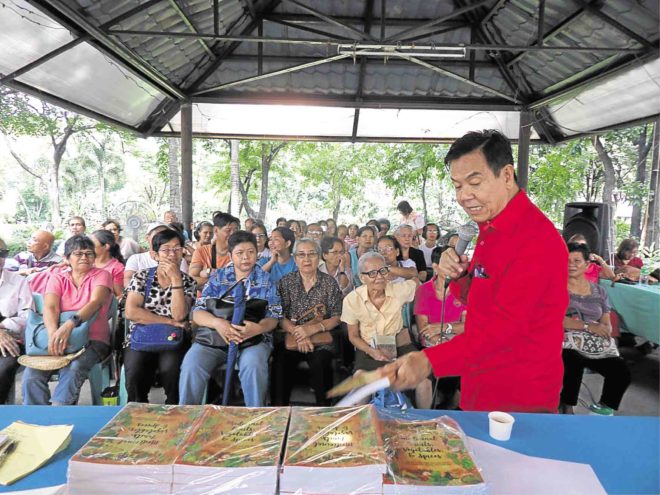
Drinking eight glasses of water a day is right—if you live in a temperate country. But former Health Secretary Dr. Jaime Galvez-Tan, a staunch and passionate advocate of alternative, natural therapies, says that Filipinos, being in a tropical country, should drink more, about 12-15 glasses, because of dehydrating higher temperatures.
Galvez-Tan also reiterates what other health advocates preach—wash your hands as often as you can. If you do not know it yet, simple hand-washing is arguably the simplest but most effective way to prevent many diseases, including potentially fatal infections.
And, for Galvez-Tan, many of the vegetables mentioned in the folk song “Bahay Kubo” do not only make for a lush garden but also provide cheap, convenient and fresh remedies for various ailments, even serious, chronic diseases.
He lists the medicinal values of some plants that Filipinos are familiar with, and have easy access to, in his latest book, “Medicinal Fruits, Vegetables & Spices,” released recently at the Quezon City Memorial Circle under the auspices of Green 2000, a retailer of herbs and medicinal plants owned by Adela Ang.
Practical
The book, a collaboration between Galvez-Tan and his nurse wife Rebecca, is “a slimmer volume because it is easier to carry and use. The language is also simpler and very practical for the ordinary lay person.”
Galvez-Tan says the plants discussed in his new book grow in the Philippines. There is enough scientific evidence that they are, indeed, effective. Although some “fruits are seasonal, their leaves and stems and other parts can be used” and are available year round, he adds.
“The fruits, vegetables and spices in the book are easily identifiable and are familiar to most Filipinos. Other herbs like lagundi, sambong, tsaang gubat and niyog-niyogan are difficult for the ordinary Filipino to identify, while papaya, kamias, mustasa and kalabasa, etc., for example, are well-known,” says Galvez-Tan.
The therapeutic properties of plants like luyang dilaw (turmeric), avocado, ampalaya, mangosteen, garlic, guava, tomato, cucumber and kalamansi are familiar to many Filipinos, but they may be unfamiliar with the medicinal values of others.
Anise (fennel) revives a person who has fainted and for gas pain; anonasis a good source of vitamin C and carbohydrates and relieves diarrhea; the atis’ seeds will kill lice; balimbing is a cooling drink for people with fever; duhat—relieves diarrhea; gabi (taro) has a precursor steroid for rheumatism; granada (pomegranate) has antifungal and antibacterial properties; kamatsile—combats gum diseases and toothache; kamias is for fever, as a cooling drink; kaymito relieves diarrhea; lansones is for diarrhea and intestinal worms; makopa is for mouth and throat infections, fever, diarrhea and stomachache; sampalok—is for aromatic bath and for constipation and cough; sineguelas is for constipation, diarrhea, swollen lymph nodes and contusion, wounds, cuts, sores and burns; and tsiko is also for diarrhea.
Some plants, while readily accessible, may be unknown to many: balanoy (sweet basil) is for cough; burburtak has been found to have high iodine content and has antimicrobial properties; kolitis is for fever, insect bites and general wellness; lipote is for cough, hypertension (high blood pressure) and inflammation; roselle reduces risk of hypertension and hyperlipidemia (high level of lipids like fats, cholesterol and triglycerides) and is an antioxidant.
‘Ashitaba’
Galvez-Tan also extols ashitaba but points out that what many people are currently growing in their gardens is not the real thing, but is Gynura procumbens. (See sidebar on page C3.) The true ashitaba has celery-like leaves. Its roots, stems and leaves may be used as food and medicine.
Studies have found that the whole plant may be used as a tonic to improve health and increase longevity, aid digestion, hasten wound healing and increase mother’s milk production, and as a diuretic (increase urine production so the body expels more toxins).
“Ashitaba has been used for centuries, both as vegetable and medicine in Japan, Taiwan, Korea and China,” says Galvez-Tan. “There have been no adverse effects. In the Philippines the only ‘adverse’ effect is that… Gynura has been popularized as ashitaba… Many people eat Gynura as vegetable and medicine rather than the real ashitaba (scientific name Arcangelisa).”
Galvez-Tan says things have changed a lot since he started to campaign publicly for medicinal plants in 1978. “Many doctors are now open to the use medicinal plants more than ever. More ordinary Filipinos have come out in the open to use medicinal plants. They have known this for quite some time from their own grandparents.
“They were much like ‘closet’ users. But with doctors and other health professionals now using them, ordinary people find it more comfortable to use and talk about them.”
Natural remedies
The popularity of lagundi as a cough medicine, through a formulation by Dr. Nelia Maramba of the University of the Philippines, appears to have paved the way for other natural remedies. “The use of ampalaya created a substantial dent in the market for synthetic antidiabetic drugs that during the period 2001-2002, the pharmaceutical industry panicked to the point of [getting] a high government official [to] issue a directive calling ampalaya’s use for diabetics only a folkloric tradition and not scientific,” Galvez-Tan says.
He adds that some pharmaceutical companies, on the other hand, have entered the herbal medicine market. “If you can’t beat them join them. Lagundi is now being produced and marketed by seven different companies, including one of the biggest pharmaceutical firms.
“A company has come out with a guava wound wash. Many multinational companies have made soaps, shampoos and lotions containing medicinal plants like coconut oil, papaya, aloe vera, lemongrass, etc.
“The popularity of green tea, as compared to black or oolong tea, is also a reflection by the greater public that green tea has health benefits.”
As his enthusiastic audience at the book’s release showed, many Filipinos are returning to their medical roots. —CONTRIBUTED